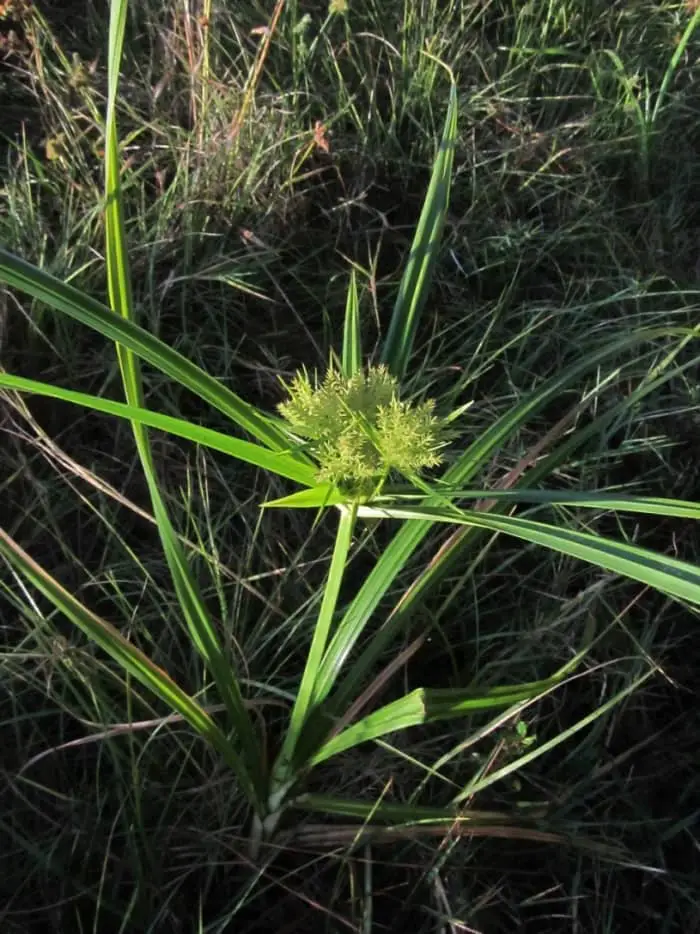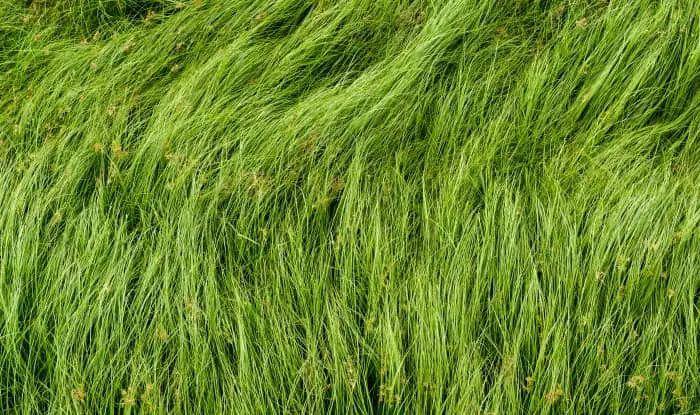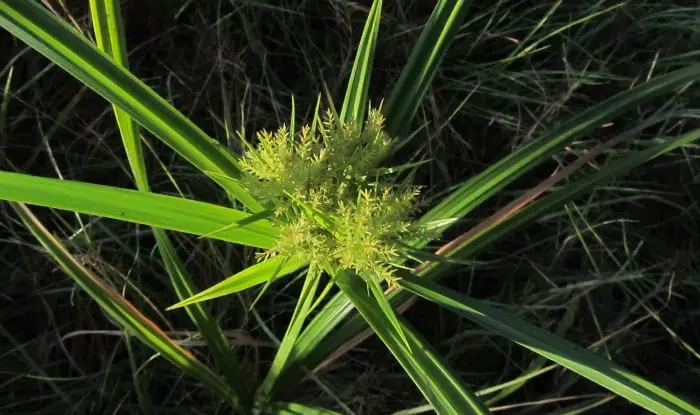Nutsedge is a common nuisance for gardeners.
It grows and spreads quickly, creating an eyesore on well-kept lawns. And if left alone, it can start to take over.
Not only that, but its extensive roots and tubers (known as ‘nuts’ or ‘nutlets’) make it hard to successfully remove once it’s established.
But fortunately, there are some things you can do.
In this article, I’ll show you how to get rid of nutsedge in your garden.
Let’s dive in.
What Is Nutsedge?

Yellow nutsedge by Homer Edward Price, CC BY 2.0
Also known as nutgrass, nutsedge is a perennial weed that’s very difficult to control.
The problem lies with its extensive root network, that spreads through rhizomes, bulbs, and tubers. Each tuber creates hundreds of new shoots and results in another 100+ tubers as the weed spreads.
Tubers survive in the soil for 2 years or more in moist conditions, and are mostly found in the top 6 inches of the soil.
But they’re sometimes deeper. And to kill nutsedge you also have to take care of the tubers to prevent further growth. Failure to completely remove them will also see the weed return the next season.
How To Identify
While it looks like a grass, it actually isn’t. It’s a sedge. And upon closer inspection, it stands out from the rest of your lawn in a number of ways.
Firstly, it’s a lighter green color. It also grows a lot faster than your lawn grass. So if you see a taller, grass-like plant towering over the grass beside it then it’s probably nutsedge.
If you look at the blades you’ll notice they’re thick and stiff. And grow from the stems in sets of 3 rather than the sets of 2 that you normally see with grasses. They also look waxy or shiny.
The stem itself is shaped like a triangle, which you can feel when you roll it between your fingers.
When the plant matures, it develops flowers and a cluster of seed heads at the top of the stalks.
How To Get Rid Of Nutsedge

You have a choice when getting rid of nutsedge:
You can either use chemical herbicides. Or use a natural method of weed control if you’re committed to organic gardening.
Let’s take a closer look.
Using Herbicides
Post-emergent weed killers are designed for use on plants that are already growing.
You can get non-selective weed killers that kill all plants you apply them to, including nutsedge. But they’ll also harm your lawn. So you have to be very careful when using them.
Instead, it’s usually better to get a selective weed killer that’s designed to kill nutsedge and other broadleaf weeds without killing grass.
But even when choosing a herbicide you still need to check the product is okay for your type of grass. Because grasses such as St. Augustine and bermuda grass are not on the recommended list of many products.
Adding a surfactant to the weed killer also improves results by helping it to stick to the nutsedge leaves.
Use a hand-pump sprayer, or weed-killer sprayer to apply the herbicide and surfactant.
It’s not recommended to mow your lawn for a couple of days before you apply the herbicide. You want the leaves of the nutsedge plant to absorb the chemical and carry it to the roots, killing the tubers as well.
It usually takes a few weeks to see the full effects. And one treatment might not be enough to completely get rid of all the nutsedge in your lawn or flower beds. So you should re-treat it throughout the summer.
You can also get pre-emergent herbicides that can suppress the growth of yellow nutsedge and purple nutsedge when applied to the ground at the right time of year. Examples of these include Pennant Magnum and Freehand.
Removing Nutsedge By Hand
To successfully get rid of nutsedge by hand you have to remove the plant including all of the roots, tubers, rhizomes, and bulbs. These are found in the top 12-18 inches of the soil.
To do this you’ll have to dig with a trowel next to the nutsedge plant. Once you’ve dug around the plant and loosened it in the soil, you can gently pull it out, taking care not to break off roots and leave them behind.
After the plant and root system is removed, continue to dig out any leftover roots you can see in the soil. And throw everything you remove in the trash.
Using Sugar
The best time to try this method is the spring when nutsedge is growing and spreading the most and has the greatest nutrient requirements.
It works by feeding micro-organisms in the soil, giving them a boost, and encouraging them to take more of the nitrogen that nutsedge needs from the soil. This effectively starves the plants as they’re not good at adapting to a low nitrogen environment.
When doing this at home you can use granulated sugar or a molasses spray (molasses are approximately 40% sugar and provide sulfur, carbon, and potash to micro-organisms).
Sprinkle the sugar over your lawn, particularly around the root zone of the nutsedge plants. And then water it in. And if using the molasses, mix 1 cup of liquid molasses per gallon of water. Then spray the area using the best weedkiller sprayer you can get.
This may require you to repeat the nutsedge treatment 2 or 3 times, each spaced by a week, to stop the nutsedge growing. This allows your grass a chance to crowd it out.
How To Prevent Nutsedge Naturally
There aren’t any tips that will help you completely prevent nutsedge from growing in your yard. But these are some best lawn care maintenance practices to reduce the chances of it getting a foothold:
Mow Your Turf High To Help Control Nutsedge — mowing your lawn on its highest setting allows your grass to crowd out nutsedge and other broadleaf weeds.
Grow A Thick Lawn — Fertilizing regularly can help you to grow a thick, lush lawn that can prevent nutsedge and other broadleaf weeds from becoming established.
Improve The Drainage — Nutsedge likes to grow in soil with high moisture levels. So you’re most likely to see it growing in areas of your garden that drain poorly. Proper drainage will make the area less inviting.
Careful Watering — Because nutsedge likes to grow in very moist soil you have to be careful with your watering habits. Daily watering in short bursts keeps the soil wet and helps nut grass to thrive. Instead, try deep waterings 1-2 times per week.
Featured Image by Homer Edward Price, CC BY 2.0

